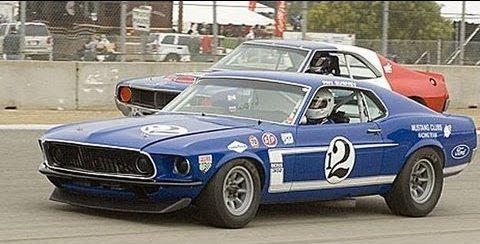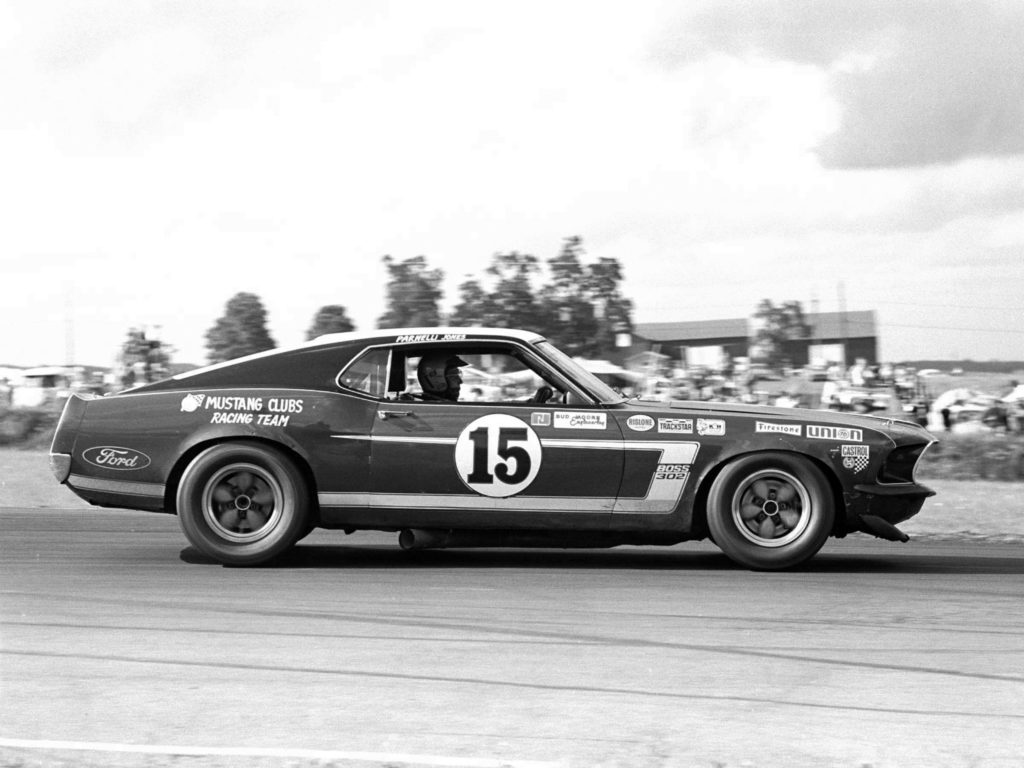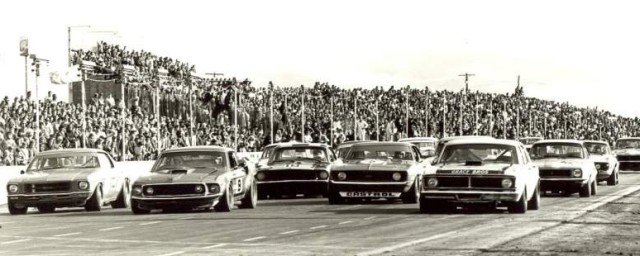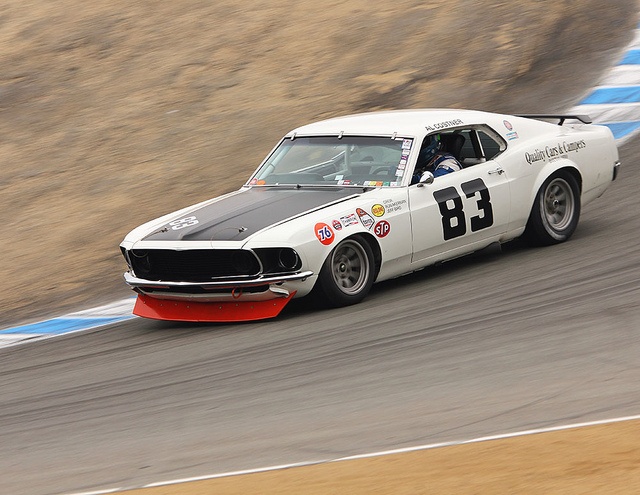The Boss 302 – The Disappointing 1969 Season
| Shelby Racing Menu | 1970 TransAm Racing | 1970 Trans-Am Schedule | ’69-70 Trans-Am Gallery |
| 1969 TransAm Racing | 1969 Trans-Am Schedule | Group 2 Racing |
The ’68 Trans Am season proved to be very disappointing to Ford and Shelby Racing Company. After beating Ford’s official team, the Bud Moore Cougars, during the ’67 season, Shelby’s notchback Mustangs had much stiffer competition in 1968. GM’s new weapon, the Z-28 Camaro, was a very formidable foe. Mark Donahue, driving a Roger Penske Camaro, won 10 of 12 races, including eight straight wins taking the ’68 Trans Am trophy. The Mustang team only won two races, the first one at the 24 Hours of Sebring and the next to last one at Riverside.
The old Mustang body wasn’t as streamlined as the new Camaros, Javelins or the Barracudas. Just in time for the racing season, Ford introduced a new Mustang and a new engine in 1969. The ’69 Mustang body was completely redesigned to make the car more aerodynamic. The previous body styles were far too boxy to slice through the air. Many of the previous Shelby Mustang features were incorporated in the new design including a rear spoiler. But the shape of the body was secondary to the new secret weapon under the hood. During the disappointing ’68 season, the teams raced a special tunnel port 302. The heads were impressive but the engine was a problem. The Shelby team went through 30 Ford supplied engines during the 1968 racing season. Ford wouldn’t let the Shelby team go back to the proven 289. The new, Ford 351 head was scheduled for ’70. First used on the tunnel blocks, this new head design, made in Cleveland, had large staggered valves & huge ports. In fact, the first production Boss 302 Mustangs had tunnel port blocks (Casting numbers C80E-6015-B) The only difference between the Boss 302 heads and the 351 Cleveland heads were some water passages.
Ford didn’t intend to take any chances in ’69. Jacque Passino was put in charge of the Ford racing efforts as head of Ford’s Special Vehicle Activities. Passino saw the excitement in the stands and knew it would sell Fords. Homer Perry coordinated Ford’s Trans-Am efforts. Perry was involved with the GT 40 racing at LeMans. Perry’s contact at Shelby Racing was Lew Spencer. Bud Moore was the Moore team contact. Perry also worked closely with Kar Kraft’s lead Trans-Am engineer, Lee Dykstra. Dykstra designed the suspension for the Mustangs.
Ford had Shelby Racing test engines with different heads at the end of 1968 to see what combination worked best. They tested the tunnel port 302, the Engine and Foundry 302 (later known as the Boss 302. The 302 block with 351 heads.), and the Gurney-Eagle 302. The Gurney-Eagle proved to be the better engine, but Bill Gay, Chief Engine Engineer, prevailed saying the Cleveland heads were factory production and would be a lot cheaper than the exotic Gurney-Eagle ones for racing and street use. Gay said, they were going to do it, it will work, and we’ll make it work.
The Mustangs raced during the ’69 season were shipped from the factory as 4-speed, 351 Fastbacks, not as Bosses. A change in the SCCA rules allowed the fastback body to be raced, prior to this only the notchback coupes could be used. (When Shelby got the Mustang sanctioned for racing he did it with Fastbacks with no back seats, therefore coupes had to be raced since the rules required a back seat in the production cars.) The race cars were started in late ’68, even though production cars weren’t scheduled until April ’69. Seven Mustangs ordered from Dearborn, stripped with no paint on December 3, 1968. A month later they were shipped. The serial numbers were 9F02M148623 to 148629. They were sold to Ford Administrative Services for $2,411 each. The prototype Trans-Am Mustangs were originally 428 Mach 1’s, these seven were basic 351 4 barrell fastbacks with 4 speeds. One car went to Kar Kraft. Three went to Shelby American and the last three went to Bud Moore. (The Moore team raced Mercury Cougars in 67 & 68 but the Cougars were dropped for 1969.) The cars were all stripped and rebuilt to the specifications used on the prototype Trans-Am Mustang at Kar Kraft. All special parts came from Kar Kraft. Interestingly enough, the car built at Kar Kraft was shipped completed to Smokey Yunick. Yunick was an old friend of Bunkie Knudsen, current president of Ford, from his GM days. The car was even painted in Smokey’s colors, black with gold trim. That car never was run in the Trans-Am races.
It took the Shelby team six weeks to take their cars apart and rebuild them to Trans Am specs. Each car cost about $20,000. The car’s weight was restricted to 2.900 pounds. The stock Boss 302’s weighed in at 3,250 pounds. The distribution of the weight of the cars was shuffled around so that they were 50/50 front and rear. The interiors were removed completely, although the dash pad was saved and reinstalled. The windows were all replaced with lighter glass. The windows had to work, so the regulators were fabricated from aluminum to replace the heavy cast factory units. A mandatory roll cage was extended to stiffen the body. The factory seats were replaced with one racing bucket seat. A metal bulkhead was installed to separate the cockpit and the driver from the fuel tank in the trunk. A safety harness secured the driver in place. The Shelby team replaced the stock Ford shifter with a Hurst four speed, the Moore cars used the stock shifter.
The suspension of the Trans-Am Mustangs was pure race car. Trans-Am rules prohibited moving the suspension mounting points, so the roll cage was welded directly to the car suspension mounting points for strength. The cars were aligned perfectly to the computer specifications developed by Kar Kraft for the production Boss 302’s. The A arms were replaced with heavy duty Boss 429 pieces using alloy bushings instead of the stock rubber. The 11.96 inch disc brakes from Lincoln Continental replaced the stock front discs. The stock rear discs were modified and replaced with larger 11.3 inch discs. Thicker front stabilizer bars were used. Different front bars were used depending on the track and the conditions. Heavy duty forged spindles, racing coiled springs and leaf springs installed. The leaf springs had a Watts linkage added that restricted the side to side movement, allowing the spring to move vertically only. Traction bars were welded in above the leaf springs. Adjustable Koni shocks were put at all four corners. The mounting points were moved slightly for better control, contrary to Trans-Am rules. Single or twin radiators mounted just in front of the both sides of the rear axle used the cool air under the car on the rear end differential fluid. The modifications dropped the car about 3 inches from the stock height. A front spoiler hung under the front of the car made of ABS plastic with scoops just above to channel air to the front disc brakes. The 1969 cars did not use the rear spoiler. The Trans-Am Mustangs did not have the fake cut out “scoops” in the rear quarter panels like the production cars did. The early Trans-Am cars had two quick fill gasoline caps installed on either side of the trunk lid, later cars has a single cap above the lid. The doors had to open and latch, but they were held in place with click pins instead of the stock door latches. Twelve inch Goodyear racing tires were mounted on 15″x18″ American Racing or British Mini-lite mags
The Trans-Am engines were provided by Ford’s Engine and Foundry group. They were blue printed and balanced, race ready when shipped to Shelby Racing and Bud Moore. Every racing part was heavy duty to stand the rigors of the upcoming season. In the beginning a Cross Boss intake manifold was planned, similar to Chevy’s Cross Ram intake. It had two huge 1250 cfm Holley carbs mounted in the front and rear on opposite sides. The size of the intake interfered with the distributor placement so a wider timing chain cover was made with an extension on the cam to reach the relocated distributor. But when the Holley carbs were finally available, the manifold runners were too long for power in the 5000-6000 rpm range. A single plane manifold was built with shorter runners. The intake had a runner for each of the Holley carbs eight barrels, one for each cylinder. The distributor was still in the way so a special off-set distributor was made. Since all parts used in racing had to be available as production parts, the Cross Boss intake was produced even though it wasn’t used in the races. The valve cover breathers were stock Cleveland 351 valve covers that emptied into a collector to keep oil from blowing out on the track. The racing engines had over $6,000 of parts in them, a lot of money in 1969. But these special parts took the 290 horse power stock engine to a reliable over 470 hp at 9,000 rpm.
Shelby recruited Pete Revson & Horst Kwech to drive his blue with white stripes Mustangs. Bud Moore’s drivers were Parnelli Jones & George Follmer. A seventh car was shipped to Kar Kraft for Smokey Yurick but it was never raced. The Shelby cars were painted blue with white numbers and stripes. The Shelby American drivers were Revson in the #1 car and Kwech in the #2 car. Moore’s cars were painted red and black with a white roof, hood and side stripes and numbers. Moore’s cars were driven by Follmer in the #16 car and Jones in the #15 car.
The stakes were high in 1969. It was manufacturer against manufacturer. Winning was going to require more sophisticated methods. The Shelby cars were wind tunnel tested and prepped further by Shelby’s veteran team. And the Shelby team was going to run its own Boss engines this year! Lots of other new ideas were used like as front air dams, wider tires & fender flares and rear wing-spoilers.
On the track, the Boss 302 Mustangs were simply awesome. The first race at Michigan International Speedway, Irish Hills, Michigan, was won by Parnelli Jones driving for the Moore team. The win was originally given to Mark Donahue in a Camaro with Jones in 4th. The Ford team protested and the SCCA realized that Jones’ laps had been undercounted and a couple of hours after the race Parnelli was given the win. The Jones’ Mustang was the only one that finished. Revson got stuck in the mud after running off the track. Follmer lost his clutch and Kwech crashed his car into a spectator’s car, killing the owner.
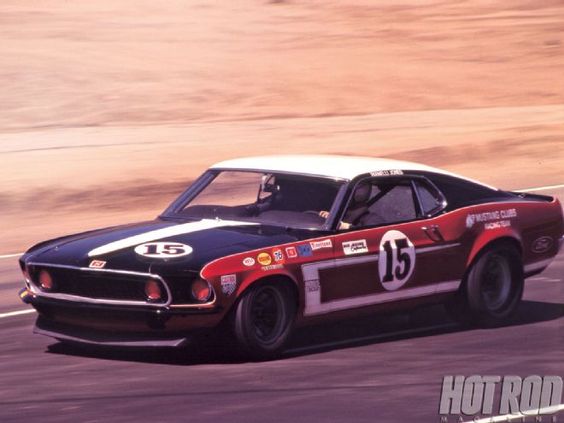
The 2nd race, held at Lime Rock, Connecticut, on Memorial Day was won by Sam Posey in a Shelby Mustang. That was the Shelby team’s only victory during the 1969 season. Three of the drivers skipped this race to drive at the Indy 500 race. Posey was driving Revson’s car #1, John Cannon piloted the #16 car of Follmer and Parnelli’s #15 Mustang was driven by Swede Savage. Kwech dropped out after 19 laps with brake problems after leading the race. Posey took the lead and stayed there. The race was between Posey and Savage. Posey broke a valve near the end of the race slowing him down. Swede put forth a huge effort to catch him, but cut a tire on debris from the track, and came in second.
In June at Mid-Ohio, even though the Mustangs ran a good race, the Bucknum Camaro slipped by finishing just ahead of the Jones’ Mustang. All the Mustangs finished. Follmer was third, Revson came in second and Kwech was 10th
At Bridgehampton, New York, Penske put Donahue in the Bucknum Camaro after his engine blew while warming it up. Even though Donahue had to start at the rear of the race since he did not qualify in the car, he fought his way to challenge the Mustangs. Follmer and Jones fought for first place for 29 laps. Jones went in for fuel leaving room for Donahue and Jerry Titus in a Chevy powered Firebird. Follmer won, Revson came in 5th. Jones went out with a broken shifter, a wiring fire and a flat tire. Kwech lost his transmission.
Following Lime Rock the Shelby Team was plagued with problems. Horst Kwech wrapped his Boss around one of the few trees on the Donnybrooke course in Brainerd, Michigan, in July, after running a great race. (Follmer’s car went out in an accident in that race as well). Parnelli Jones won at Brainerd, his fourth win out of the last five races, and Revson came in 3rd. Donahue blew the engine in his Camaro. The Ford Boss Mustangs held 42 points to Chevy’s 30, the Pontiac team at 13 and the AMC cars had 8.
The sixth race at Loudon, New Hampshire, was Donahue’s second win of the season. Jones gave him a run for first but went out with an overheated engine. Kwech’s engine broke early in the race. Revson came in third and Follmer fourth. The Mustangs had a six point advantage over the Camaros.
But the race that did in the Ford effort was at Ste. Jovite, Canada in August, 1969.The Mustangs did a tremendous job during the 3 hours of the Le Mans Circuit Trans Am that warm day in Canada. Jones, Follmer and Donahue fought for the lead until the ninth lap. Jones’ shift linkage jammed taking him out of the race. But the worse happened in Lap 14. Follmer’s Boss blew an engine and spewed oil all over the track causing him to hit a guard rail. He had just gotten out of the car when a Mini plowed into his Mustang. Kwech slide into the fence pinning a marshal, breaking his arm. Revson hit the mess at speed jumping one car and landing on the hood of a Firebird. Three Mustangs were involved as well as a lot of the other cars in the race. The Mustangs weren’t damaged that badly in the pileup. But after the tow trucks were finished so were the cars. A tow truck driver looped a steel cable around the roof of Kwech’s Mustang to lift it over the guardrail doing serious damage to the car. All three Mustangs were all but destroyed. Donahue managed to miss the accident and went on to win the race. Camaro now lead the series, 49 to 46.
All the Mustangs were taken back to Detroit to salvage what was left. A couple of Boss racers were assembled from the wrecks of the three Bosses in the week between races. They were raced but not successfully. The welded and pieced together bodies just couldn’t perform like the original ones.
At Watkins Glenn, only three Mustangs made it to the track. Kwech’s car was out of the race. Jones took the lead early in the only original Boss but went out with a bad tire. Donahue took the lead. Both Donahue and Jones were black flagged for passing under a caution flag. And both had to see the track steward. Donahue got there first and got back on the track while Jones was still getting his lecture. Parnelli never caught up. It was Donahue’s third straight win. Follmer and Revson did not finish. The Camaro team now had 58 points to the Mustangs 52.
In August , at Laguna Seca in California, Dan Gurney replaced Horst Kwech in one of the Shelby cars. Ford felt Kwech wasn’t the right driver. He had only finished one race. Gurney brought his own mechanics. It didn’t make any difference. Jones and Follmer traded first place until the sixth lap when Jones went out of the race with rear end problems. Follmer lead until a brake line broke. He went out of the race with a cracked wheel. Donahue won his fourth race. Gurney came in third. Revson was fourth. The Penske Camaro team now had 67 points to the Ford team’s 56. After that race Gurney complained that the Shelby team wasn’t getting the best parts, that they were going to Moore instead. But Lew Spencer said the Shelby team’s problems came from the loss Chuck Cantwell to the Penske team. Cantwell had been the Shelby team’s suspension man. Spencer felt without Cantwell, the Moore team was ahead of the Shelby team.
At Kent, Washington, the Ford team needed to take first and second to catch the Camaro team. Ford rented the track prior to the race to try and sort out the problems with the cars. During the race, Parnelli Jones’ held the lead for the first 74 laps. Donahue blew his Camaro’s engine. It was looking up for the Ford team Jones pitted with a stuck safety valve in his fuel tank. Bucknum took the lead. Jones got back in the race and gave it another valiant effort. During the last lap, he blew a tire and crossed the finish line with sparks flying coming in second to Bucknum. Revson finished in fourth and Dan Gurney came in tenth. Follmer had an accident in lap 129, almost at the end of the 135 lap race. Five straight wins for the Camaro team gave them 72 points to Ford’s 62.
The September race at Sears Point in Sonoma, California, gave the Penske team another chance to out perform the Ford team. Revson was out of the race with carb problems. The Jones’s pit team was a lot slower than Donahue’s. Even though Jones lead most of the race, Donahue’s team had his Camaro back on the track much faster. Donahue’s team did his three pit stops faster than Jones’s team did his two. In the final seven laps. Jones was driving like a wild man, sliding around corners, locking up his brakes, speed shifting in the straight aways
The season ended with the Boss Mustangs only giving a great showing. Mark Donahue, driving his Penske Camaro, out did the Mustangs again to win the 1969 championship. But it took Donahue winning six of the last seven races to beat Parnelli Jones and the remaining Mustangs. Moore’s team was faster and more dependable than the Shelby team earning Ford’s full support by the end of the season. The race wasn’t just to win with the Mustangs. It was also to see who carried the Ford flag next season. The Shelby American team was out.
Ironically, Shelby American won Ford the 1966 and 1967 Trans Am Manufacturer titles before the 1970 trophy without factory support.
Continue reading about Ford’s efforts to win the Trans Am Championship in 1970 or read the 1969 Trans-Am schedule and 1970 Trans-Am schedule to see the Boss Mustang finishing results.
For more information about Ford’s Trans Am efforts check out:
– Bud Moore Engineering. They have a great history section. Nice set of pages
– National Tire and Battery Trans Am series with a historical section with Trans Am information.
Source of information: The Shelby American #41 from SAAC (The Shelby American Automobile Club); A great book on Boss 302’s called Mustang Boss 302, Ford’s Trans-Am Pony Car by Donald Farr
